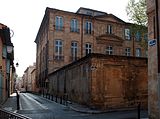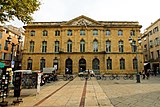Georges Vallon
Georges Vallon | |
|---|---|
| Born | 26 December 1688 |
| Died | 7 November 1767 (aged 78) |
| Nationality | French |
| Occupation | Architect |
| Parent | Laurent Vallon |
Georges Vallon (1688–1767) was a French architect. Many of his buildings are listed as "monuments historiques".
Biography[edit]
Early life[edit]
Georges Vallon was born in 1688. His father, Laurent Vallon (1652–1724), was a renowned architect.[1] He was trained in Languedoc, Lyon and Paris.[1]
Career[edit]
Like his father, he became a renowned architect.[2]
In Aix-en-Provence, he was commissioned by Jean-Baptiste d'Albertas (1716–1790) to design the Place d'Albertas, which has been listed since 2000.[3][4][5] Additionally, he designed the Palais de l'université located on the Place de l'Université on the Rue Gaston de Saporta opposite the Cathédrale Saint-Sauveur in 1734, which formerly housed the law school and now houses Sciences Po Aix.[6] It has been listed since 1929.[7]
He also designed several buildings on the Cours Mirabeau in Aix. For example, in 1730, he designed the Hôtel du Poët for Henri Gautier (1676–1757), located at the very top of the Cours, and listed since 1987.[8] Moreover, in 1757, he designed the facade of the Hôtel d'Esmivy de Moissac at the bottom of the Cours, listed since 1993.[9][10]
Together with Robert de Cotte (1656–1735) and Jean Aubert (1680–1741), he also designed an hôtel particulier called the Hôtel de Caumont, also listed.[11]
With his father, he also designed the Halle aux grains, another listed building since 1983, which was built from 1717 to 1759 and now houses a post office and a library.[12]
Vallon designed the Bastide du Jas de Bouffan on the outskirts of Aix for Gaspard Truphème circa 1750.[13] It was acquired by Louis-Auguste Cézanne in 1859, where his son, painter Paul Cézanne, lived until 1899.[13] It has been listed since 1980.
Death[edit]
He died in 1767.
Gallery[edit]
References[edit]
- ^ a b Albert Aynaud, Aix-en-Provence, ses fontaines et leurs secrets, 10, bd Roi-René, 1969, p. 175 [1]
- ^ Jean-Jacques Gloton, 'Quatre hôtels aixois bâtis en 1757', Bulletin de la Société de l'Histoire de l'Art français, December 4, 1976, pp. 189-200
- ^ Base Mérimée: Immeubles formant la place d'Albertas, Ministère français de la Culture. (in French)
- ^ Dominique Auzias, Jean-Paul Labourdette, Provence, Le Petit Futé, 2011, p. 191 [2]
- ^ Christian Freigang, Rolf Toman, Provence: art, architecture, landscape, Könemann, 2000, p. 198 [3]
- ^ Dominique Auzias, Aix-en-Provence, Le Petit Futé, 2008, p. 142
- ^ Base Mérimée: Faculté de Droit, Ministère français de la Culture. (in French)
- ^ Aix-en-Provence Tourism: Hôtel du Poët Archived 2013-12-15 at the Wayback Machine
- ^ Base Mérimée: Hôtel d'Esmivy de Moissac, Ministère français de la Culture. (in French)
- ^ André Bouyala d'Arnaud, Évocation du vieil Aix-en-Provence, Les Éditions de Minuit, 1964, pp. 179-180
- ^ Base Mérimée: Hôtel de Réauville ou de la Tour d'Aigues ou de Caumont, Ministère français de la Culture. (in French)
- ^ Albert Aynaud, Aix-en-Provence, ses fontaines et leurs secrets, 10, bd Roi-René, 1969, p. 77 [4]
- ^ a b Cézanne en Provence: Le Jas de Bouffan





